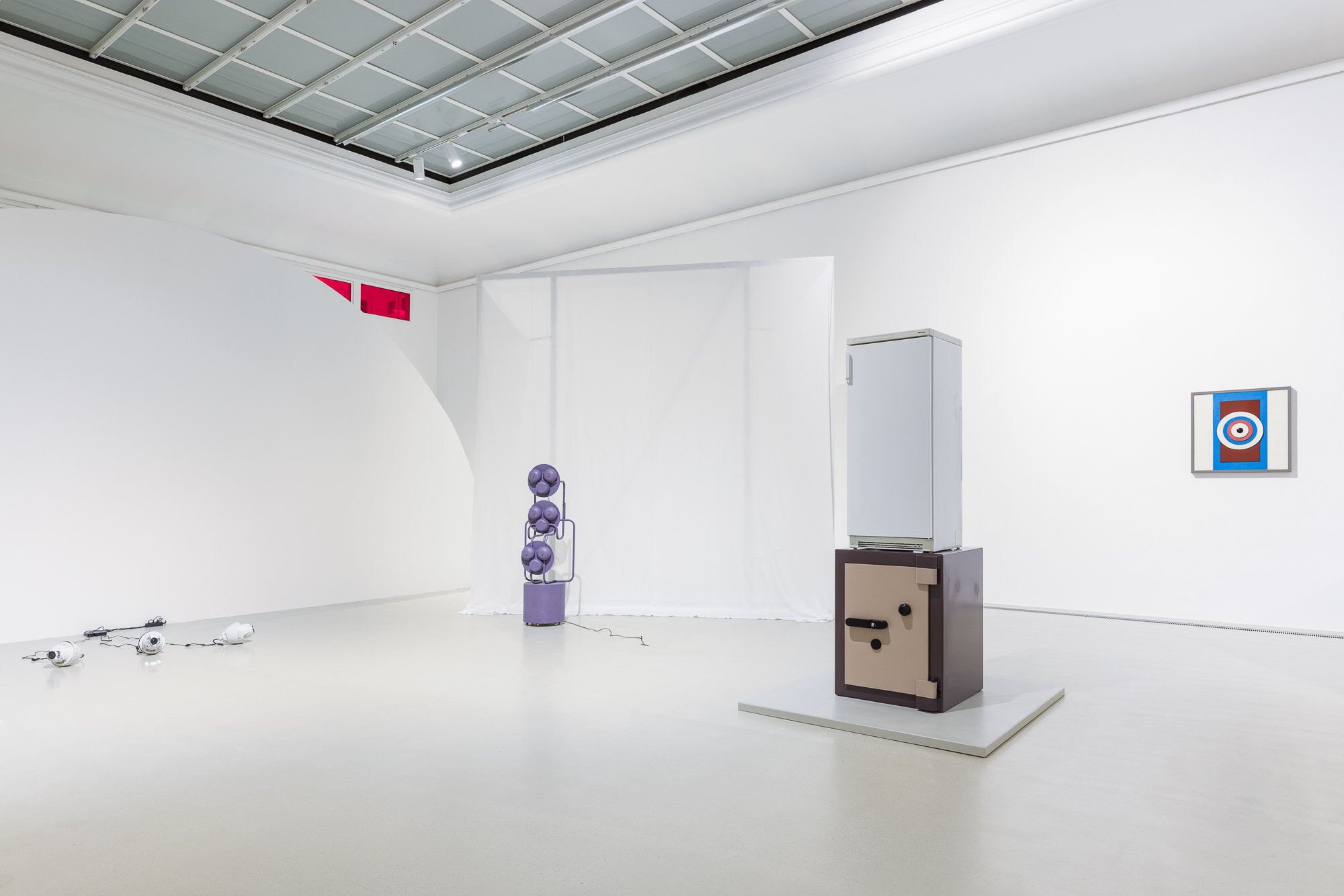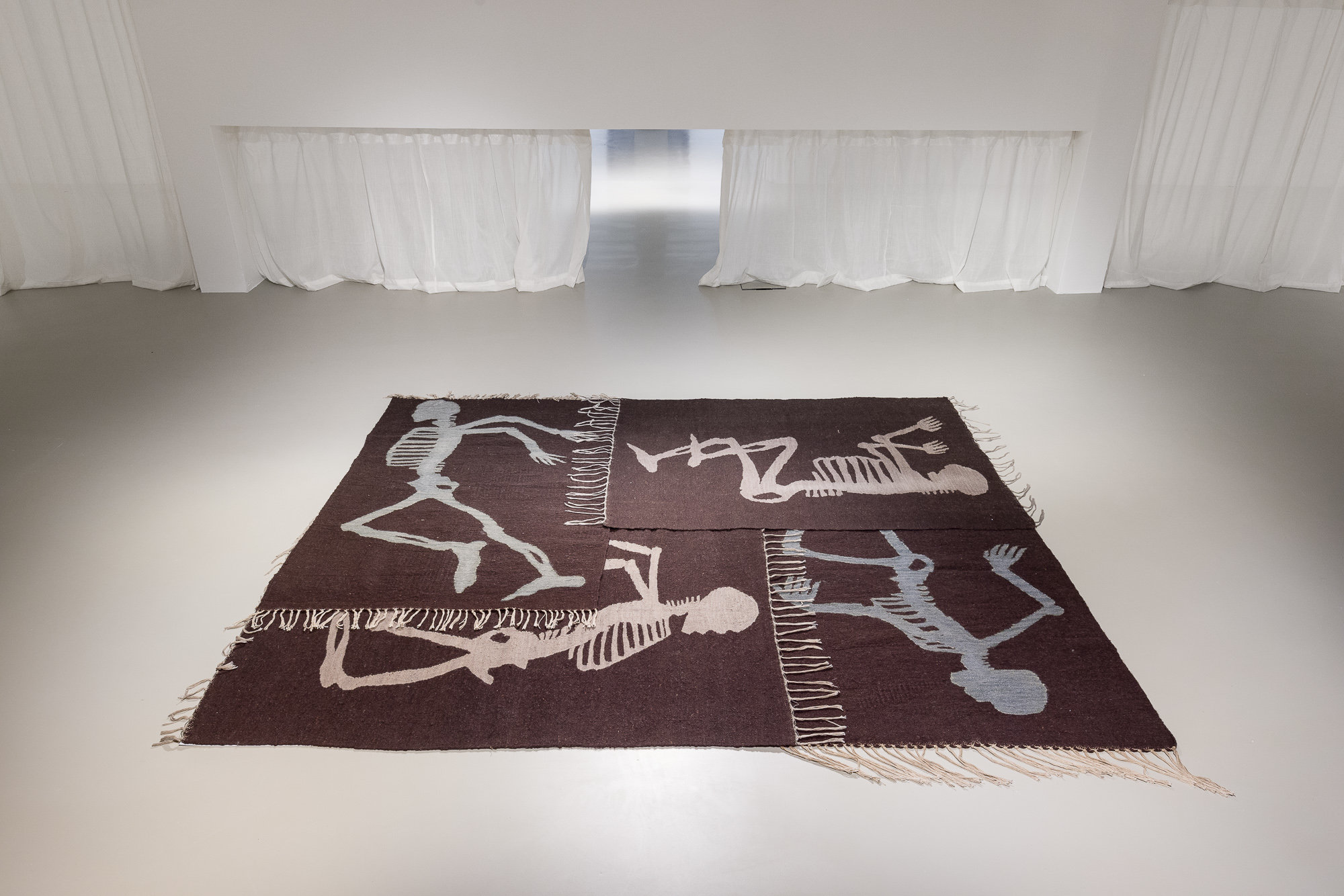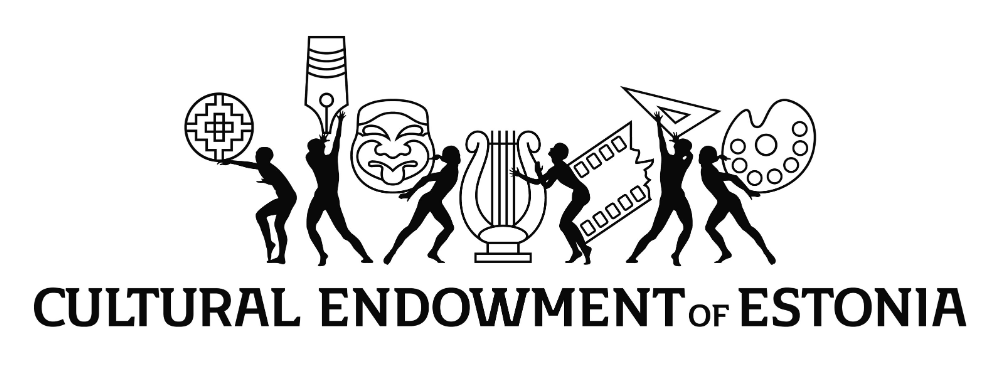Domestic DramaLarry Achiampong, Ayo Akingbade, Aram Bartholl, Camille Blatrix, Oscar Enberg, Vera Frenkel, Nigel Gavus & İlkin Beste Çırak, Antony Gormley, Mona Hatoum, Kaarel Kurismaa, Nicola L., Bertrand Lavier, Olu Ogunnaike, Laura Põld, Bruno Zhu14.12.2021–20.2.2022
Exhibition
All objects which surround us have souls of their own, have human qualities because they only exist in a human world. There are really not objects which man perceive. There are no raw inhuman objects. The moment furniture, houses, bread, cars, bicycles, or other products appear in our life, they are related to us, they are human.
Ernest Dichter, The Strategy of Desire, Martino Publishing, Mansfield, 2012. p. 93.
Views
Domestic Drama, 2021/2022
Exhibition Tour (English)
Camera & Sound: kunst-dokumentation.com

Domestic Drama, 2021/2022
Exhibition view
Photo: kunst-dokumentation.com

Domestic Drama, 2021/2022
Exhibition view
Photo: kunst-dokumentation.com

Domestic Drama, 2021/2022
Exhibition view
Photo: kunst-dokumentation.com

Domestic Drama, 2021/2022
Exhibition view
Photo: kunst-dokumentation.com

Domestic Drama, 2021/2022
Exhibition view
Photo: kunst-dokumentation.com

Camille Blatrix, K.O Box, 2021
Tainted wood, printed plastic, resin
45 × 60 cm
Commissioned by HALLE FÜR KUNST Steiermark
Courtesy the artist, Andrew Kreps Gallery, New York
Photo: kunst-dokumentation.com

Aram Bartholl, Pan, Tilt and Zoom, 2018
CCTV surveillance cameras, cable, variable dimensions
Photo: kunst-dokumentation.com

Domestic Drama, 2021/2022
Exhibition view
Photo: kunst-dokumentation.com

Antony Gormley, Home, 1984
Lead, terracotta, gypsum, fiber glass
62 × 164 × 216 cm
Courtesy the artist and Museum Moderner Kunst Stiftung Ludwig, Vienna
Photo: kunst-dokumentation.com

Bruno Zhu, Inside (Domestic Drama), 2021
Wood, dispersion paint, cloth
Variable dimensions
Commissioned by HALLE FÜR KUNST Steiermark
Photo: kunst-dokumentation.com

Nigel Gavus & Ilkin Beste Çirak, It’s on a day like this…, 2021
16mm film on video, color, sound
16 min.
Commissioned by HALLE FÜR KUNST Steiermark
Photo: kunst-dokumentation.com

Larry Achiampong, The Expulsion, 2019
HD film, color, sound
15:45 min.
Courtesy the artist, LUX Distribution, London
Photo: kunst-dokumentation.com

Nicola L., Red Lip Lamp, 1969
Plexiglass, steel
129.5 × 17.1 × 7.6 cm
Courtesy Alison Jacques, London und Nicola L. Collection and Archive
Photo: kunst-dokumentation.com

Olu Ogunnaike, Piece by Piece, 2021
13 different types of wood, charcoal silkscreen print
402 x 70.2 x 80 cm
Comissioned by HALLE FÜR KUNST Steiermark
Photo: HALLE FÜR KUNST Steiermark

Vera Frenkel, This is Your Messiah Speaking, 1990
Film, double channel version
9:10 min. / 15 min.
Courtesy the artist / Distribution Vtape, Toronto
Photo: kunst-dokumentation.com

Domestic Drama, 2021/2022
Exhibition view
Photo: kunst-dokumentation.com

Laura Põld, Burrows, I (Cliff Swallow), 2019
Ceramics
69 x 96 x 29 cm
Courtesy the artist, Temnikova & Kasela Gallery, Tallinn
Photo: kunst-dokumentation.com

Kaarel Kurismaa, Ice Run, 2009
Ready-made, wood, glass
31 x 18 x 18 cm
Courtesy the artist, Temnikova & Kasela Gallery, Tallinn
Photo: kunst-dokumentation.com

Domestic Drama, 2021/2022
Exhibition view
Photo: kunst-dokumentation.com

Domestic Drama, 2021/2022
Exhibition view
Photo: kunst-dokumentation.com

Domestic Drama, 2021/2022
Exhibition view
Photo: kunst-dokumentation.com

Mona Hatoum, 4 Rugs (made in Egypt), 1998/2015
Four hand-woven wool rugs
264 x 228 cm
Courtesy the artist and White Cube, London
Photo: kunst-dokumentation.com

Domestic Drama, 2021/2022
Exhibition view
Photo: kunst-dokumentation.com

Oscar Enberg, A History of Violence, 2021
Wood (ash, oak, pine), goat´s hair, oil paint, varnish on tin, soiled cotton material, steel, copper wire
340 x 70 x 50 cm
Commissioned by HALLE FÜR KUNST Steiermark
Courtesy Robert Heald Gallery, Wellington
Photo: kunst-dokumentation.com

Kaarel Kurisma, A Growler, 1993
Ready-made, platic, electronics
173 x 50 x 50 cm
Courtesy the artist, Temnikova & Kasela Gallery, Tallinn
Photo: kunst-dokumentation.com

Ako Akingbade, Dear Babylon, 2019
16mm on HD film, 16:9, color, sound
21:10 min.
Courtesy the artist, LUX Distribution, London
Photo: kunst-dokumentation.com
Text
In 1960, Austrian-American psychologist Ernest Dichter published The Strategy of Desire, in which he presented his most important thoughts on the development of market and motivation research. On the basis of Freudian psychoanalysis, Dichter developed methods that he called “the art of influence,” designed to continually increase our desire for new commodities. At the center of his thinking rests the assumption that humans make decisions not on the basis of rational considerations but of emotions.
Our large group show Domestic Drama is an attempt to trace and conjure up the “souls” that Dichter described, which are allegedly resting in our everyday objects. The scene of this search is a place that is highly formed by emotions: the home. In hardly any other place than our own four walls, otherwise hardly tangible but nonetheless essential categories are revealed — such as our social, economic, ethnic, and gender affiliations. Living somewhere can very directly shape our social belonging and participation, and in particular precisely whenever this basic need is not fulfilled or is precarious.
In our immediate present determined by the ongoing Corona pandemic, this condition has become clearer than ever — the “home” has been transformed from a refuge to a place of permanent production, where the borders between the private and the world of work have disappeared and where the conflicts that result from this, which formerly were enacted outside, are now negotiated in the interior of our private realms.
Domestic Drama represents an attempt to understand everyday objects not as tools and objects for use, but as representatives of all of these conflicts, and of wishes and desires that shape our identities. In contrast to a purely educational and analytic approach to the theme, this exhibition intends to use direct and diverse aesthetic and conceptual strategies to create a physical and psychological space in which the processes and mechanisms described above can be experienced.
As well as the ideas of Ernest Dichter, the theories of the renowned architecture critic Beatriz Colomina also play an important role. In her essay The Split Wall: Domestic Voyeurism (1992), Colomina coins the expression “domestic drama,” from which the exhibition takes its name. Colomina explores architectural concepts of living spaces whose design derives from stage-like situations, and also makes the subjects and objects in these spaces into the protagonists of a “domestic drama.”
The architecture and the exhibition galleries of HALLE FÜR KUNST thus receive a theatrical “makeover.” The Portuguese artist Bruno Zhu (born 1991 in Porto, lives in Amsterdam and Viseu) develops a site-specific exhibition architecture in dialogue with the exhibited works. Beginning with his technological expertise in the fields of fashion and interior design, Zhu makes objects that also embody the tension between the “habitual” and the culturally unknown. His hybridized objects take up a permanently tense relationship to their environments, critically addressing the mechanisms of symbolic representation.
Alongside this large-scale installation, the artists Olu Ogunnaike and Camille Blatrix, and the artist duo Nigel Gavus & İlkin Beste Çırak will also present new works commissioned for the exhibition. The practice of Olu Ogunnaike (born 1986 in London, lives in London) comprises the production of sculptures, objects, prints, installations, and performances. The starting point for his work is the material of wood, which forms the core of his artistic idioms, permitting reflection on themes that are hard to grasp — such as origin, identity, work, and the global circulation of people and goods. In Domestic Drama the artist presents a dining table, made of various local indigenous woods in collaboration with a Graz carpenter. The table top includes an insert made of a special piece of wood that bears the image of a dining table with no particular defining features — the kind that might be found all over the world.
French artist Camille Blatrix (born 1984 in Paris, lives in Paris) creates elegant machine-like objects in a combination of industrially and hand-made parts. For this exhibition, he develops a mobile and transparent object that is somewhere between chest of drawers and chair. This functional furniture provides the museum personnel the opportunity to store their personal belongings. By including the staff who go about their everyday work the artists also sheds light on HALLE FÜR KUNST Steiermark as a place of work with emotional meaning — behind its otherwise official functions.
The artist duo Nigel Gavus & İlkin Beste Çırak (born 1992 in Graz, lives in Vienna and Graz; born 1994 in Izmir, lives in Vienna) was invited to participate within the scope of Panther Residency, a program initiated by HALLE FÜR KUNST Steiermark to promote artists from the region. For Domestic Drama the artists made It’s on a day like this… (2021), a digitalized 16-mm film that portrays a young woman spending her days sleeping in order to get free of reality. She creates her own realm of unreality by taking an interest in the things and objects around her. This film essay addresses the feeling of inner isolation and asserts the picture of a sad, lonely, and passive rebellion against the lack of perspective in the protagonist’s world.
With the intentionally “theatrical” appearance of the artistic works, and the cross-genre enactment of a living space, Domestic Drama wishes to invite visitors to participate physically. In a further step, the exhibition recognizes emotional states as key factors in our behavior and actions, which has now long been controlled not by ourselves as autonomous subjects but by the objects and processes that surround us. The poetic and also subversive and critical narrative that is spun in Domestic Drama thus attempts to focus our attention on the complexity of the questions and mechanisms of our everyday lives.
Curated by Cathrin Mayer
Artists
Participating artists
Larry Achiampong
makes use of various means of expression, such as moving images, sculptural installations, photographic-painted collages, sound documents and compositions. His repetitive content often explores postcolonial themes.
Exhibitions, performances, and projects have been shown or taken place at the following institutions, among others: Tate Britain/Tate Modern, London, The Institute For Creative Arts, Cape Town, The British Film Institute, London, Kunsthal Charlottenborg, Copenhagen, 57th Venice Biennale, Venice.
Ayo Akingbade
is an artist, writer, and director who works primarily with moving images and explores concepts such as power, urbanity, and attitude. Her interest lies in what films can evoke in terms of emotion, how it makes you pause in a moment rather than convince you of a point of view.
She has had film screenings and exhibitions at the Whitechapel Gallery, London, the Film Society of Lincoln Center, New York City, MoMA Doc Fortnight, New York City or the International Short Film Festival Oberhausen, Oberhausen.
Aram Bartholl
points with his sculptural interventions and installations to topics such as surveillance, data security or dependence on technology, which is related to our current media behavior, social networks and online platforms.
The artist gives numerous lectures and workshops. His exhibitions range from MoMA (Museum of Modern Art), Palais de Tokyo, Hamburger Bahnhof, Seoul Museum of Art, Thailand Biennale, Venice Biennale, to ZKM in Karlsruhe.
Camille Blatrix
makes sculptures which present themselves as artifacts from a near future, emulating the forms of everyday objects while obscuring their own purpose.
Blatrix‘s work will be shown in the upcoming solo exhibition at Centre d‘art contemporain la synagogue de Delme (2021), his recent solo exhibitions include Kunsthalle Basel in, Basel; Galerie Balice Hertling, Paris; CCA Wattis, San Francisco and Mostyn Museum, Wales. His work has been included in group exhibitions at Kunstmuseum St. Gallen, St Gallen; Fri Art Kunsthalle, Fribourg; Furosia, Monaco; Villa Medici, Rome; Fondation Lafayette, Paris; Hessel Museum of Art and the CCS Bard Galleries, Annandale-on-Hudson, and MRAC, Serigan. Blatrix participated in the 2015 Lyon Biennale, Lyon.
Oscar Enberg
works mainly sculpturally, his pieces are a compilation of diverse forms and materials that reference film, literature, art and society.
Recent solo exhibitions include the Stadium, Berlin; St. Joseph, Künstlerhaus Bethanien, Berlin; Hopkinson Mossman, Auckland; The Agamemnon, Frankfurt am Main; and the Sculpture Terrace, Auckland Art Gallery Toi o Tamaki; Artspace, Auckland. In 2017, Enberg was on show at Art Basel Statements and awarded the German ars viva 2018 Prize, which included exhibitions at Kunstverein Munich and S.M.A.K in Ghent, Belgium. He is currently a fellow of the Creative New Zealand Visual Arts Residency at Künstlerhaus Bethanien in Berlin.
Vera Frenkel
Preview image: early version of Frenkel’s special two-channel installation This is Your Messiah Speaking, currently on view in the Domestic Drama exhibition. Watch this space for a short biography soon.
Nigel Gavus & İlkin Beste Çırak
Nigel Gavus is a filmmaker and visual artist. He graduated from the Friedl Kubelka School for Independent Film and is currently studying at the Academy of Fine Arts Vienna. In his work he deals with time, memory, identity and the relationship between poetry and cinema. He lives and works in Vienna and Graz.
İlkin Beste Çırak is a visual artist and poet. She is a graduate of the University of Applied Arts (Social Design) and is currently studying Sculpture & Spatial Strategies at the Academy of Fine Arts Vienna. Starting from public spaces as the core of coexistence, she deals with localities, identity, cultural production and participation. She lives and works in Graz and Vienna.
Antony Gormley
first studied archaeology, anthropology and art history and is now known for his sculptures, installations and public artworks that focus on the relationship of the human body to space. In a critical examination of both his own and other people’s bodies, his works address fundamental questions about man’s position in relation to nature and the cosmos. His intention conceives the space of art as his place of becoming, of emergence, in which new behaviors, thoughts and feelings germinate.
In Austria he inspired in 2010 – 2012 by his project called “Horizon Field”, in which he distributed 100 iron figures made of solid cast iron over 8 sites and over an area of 150 km², from Mellau to Dalaas (Vorarlberg), in the Alpine region.
Gormley was awarded the Turner Prize in 1994 and since being knighted in 2014 he has been allowed to use the title “Sir”.
His numerous exhibitions range from the National Gallery, Singapore, Schauwerk Sindelfingen, Sindelfingen, Kunsthaus Bregenz, Hayward Gallery, London to Malmö Konsthall, Sweden.
Mona Hatoum
Through her poetic and radical oeuvre, the Palestinian-British artist explores themes of home and displacement, gender and differences, and exposes the contradictions and conflicts of our world today. Recent solo exhibitions include the Tate Modern, London; Kiasma Museum of Contemporary Art, Helsinki; and Mathaf: Arab Museum of Modern Art, Doha.
She was part of the documenta 14, Kassel; other selected group exhibitions took place at Martin-Gropius-Bau, Berlin; MoMA, New York; Israel Museum, Jerusalem; Wexner Center for the Arts, Columbus, a.o.
Kaarel Kurismaa
is a multidisciplinary artist from Estonia, who works in the field of Soundinstallation, Kinetic Art, Sculpture, Painting and Design. His works were displayed in solo exhibitions at Tartu Art House, Tartu; Kumu Art Museum, Tallinn; the Retretti Art Museum, Punkaharju, Finnland; and at Temnikova & Kasela Gallery, Tallinn. He was also included in several group shows, for example at Garage Museum of Contemporary Art, Moscow; Academy of Arts, Berlin; the Zimmerli Art Museum, New Jersey; and at SALT Galata Gallery, Istanbul.
Nicola L.
developed a multidisciplinary practice that playfully merged the principles of art and design.
Her work will be shown in the upcoming solo exhibition at Alison Jacques Gallery, London (2021); her recent solo exhibitions include Sculpture Center, New York; Elga Wimmer PCC, New York; and the Liverpool Biennial, Liverpool.
Selected group exhibitions are at the Hammer Museum and The Huntington Library, Art Museum and Botanical Gardens, Los Angeles; Musée d’Art Moderne et Contemporain (MAMAC), Nice; Friedman Benda, New York; Elga Wimmer PCC, New York; Arsenal Contemporary, New York; Palazzo Pisani, Piano Nobile, Venice Biennial, Venice; Hauser & Wirth, New York; Tate Modern, London; Beaux-arts Buxerolles, Buxerolles, France; and SECCA (Southeastern Center for Contemporary Art), Winston-Salem, North Carolina.
Bertrand Lavier
disrupts our traditional habits of seeing with his visually appealing works, questioning our intellect, but always with a sensitive wink. He gained international fame for painting pictures and objects, but especially for his “Superpositions,” the juxtaposition of two different objects from the world of commodities that are absurdly related.
Lavier has had exhibitions at the Centre Georges Pompidou, Paris; ZKM, Karlsruhe; Haus der Kunst, Munich; Schirn-Kunsthalle, Frankfurt; Biennale di Venezia, Venice; documenta 7 and documenta 8, Kassel; and the 18th São Paulo Biennale, São Paulo.
Olu Ogunnaike
is an artist whose practice is positioned between experiments in sculpture, drawing, performance and installation.
Ogunnaike is currently exhibiting at Cell Space, London (2021). Recent projects took place at Villa Lontana, Rome; and at Tate Modern, London as part of ‘ELC TV Dinner Episode III, at Jupiter Woods, London; and at Greatorex, London with selected group exhibitions including, Espace Arlaud, Lausanne; Sophie Tappeiner, Vienna; Doc, Paris and PS120, Berlin. Ogunnaike participated in the residency program at Wysing Arts Centre, Cambridge in 2018 and South London Gallery in 2017.
Laura Põld
is an interdisciplinary artist from Estonia, who has been awarded with a number of prizes and scholarships like the Eduard Wiiralt scholarship, Ado Vabbe scholarship, annual prize of The Cultural Endowment of Estonia, Köler Prize grand prix, and the grand prize of The Cultural Endowment of Estonia.
She has recently exhibited at Kunstraum Memphis, Linz; Vienna Art Week Open Studios program, Vienna; Gallery Vaal, Tallinn; ARS Showroom, Tallinn; Tartu Art House, Tartu; Gallery Hobusepea, Tallinn; Kunda Cement Museum, Kunda; Atelierhaus Höherweg e. V., Düsseldorf; Gallery Maebashi Works, Japan; Christianshavn, Copenhagen; Tartu Art Museum, Tartu; and the Gallery Chemin du Bonheur, Hokuto-shi, Yamanashi.
Bruno Zhu
Recent projects include presentations at Fri Art Kunsthalle in Fribourg, UKS in Oslo, and Frans Hals Museum in Haarlem, Antenna Space in Shanghai, and Kunsthalle Lissabon in Lisbon. Zhu is a member of A Maior, a curatorial program set in a home furnishings and clothing store in Viseu, Portugal.
Reviews
- FRIEZE, "Domestic Drama Retreats into the Private Realm", Chloe Stead Online, 18.1.2022
- SPIKE, "Cult of Domesticity", Sophia Rohwetter Online, 15.2.2022
- Kleine Zeitung, "Inszenierung von Wohnraum", Wenzel Mraček Print, 16.12.2021, PDF (651 KB)
- Contemporary Art Library, Los Angeles Online
Press
Downloads & Dates
- Pressetext Domestic Drama PDF (1 MB)
- Press text Domestic Drama PDF (1 MB)
- Invitation card Domestic Drama PDF (586 KB)
Partners
This exhibition is supported by

